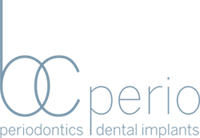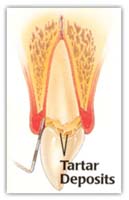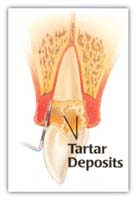The main cause of periodontal disease is bacteria in the form of a sticky, colorless plaque that constantly forms on your teeth. However, many factors (see periodontal disease page) can cause periodontal disease or influence its progression.
Your bone and gum tissue should fit snugly around your teeth like a turtleneck around your neck. When you have periodontal disease, this supporting tissue and bone is destroyed, forming “pockets” around the teeth.
Over time, these pockets become deeper, providing a larger space for bacteria to live. As bacteria develop around the teeth, they can accumulate and advance under the gum tissue. These deep pockets collect even more bacteria, resulting in further bone and tissue loss. Eventually, too much bone is lost, and the teeth need to be extracted.
Our doctors have measured the depth of your pockets. A pocket reduction procedure has been recommended because you have pockets that are too deep to clean with daily at-home oral hygiene and a professional care routine.
During this procedure, Dr. Crump folds back the gum tissue and removes the disease-causing bacteria and tartar before securing the tissue into place. In some cases, irregular surfaces of the damaged bone are smoothed to limit areas where disease-causing bacteria can hide. This allows the gum tissue to better reattach to healthy bone.
What are the benefits of this procedure?
Reducing pocket depth and eliminating existing bacteria are important to prevent damage caused by the progression of periodontal disease and to maintain a healthy smile. Eliminating bacteria alone may not be sufficient to prevent disease recurrence.
Deeper pockets are more difficult for you and your dental care professional to clean, so it’s important for you to reduce them. Reduced pockets and a combination of daily oral hygiene and professional maintenance care increase your chances of keeping your natural teeth — and decrease your chances of serious health problems associated with periodontal disease.


